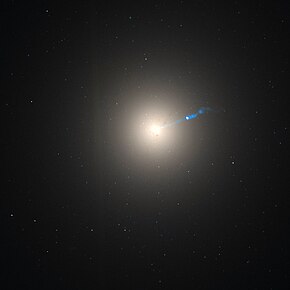
Back Messier 87 Afrikaans مسييه 87 Arabic Galaxa elíptica M87 AST NGC 4486 Azerbaijani M87 (аб’ект Месье) Byelorussian M87 BE-X-OLD M87 Bulgarian Messier 87 BS Verge A Catalan NGC 4486 CE
| Messier 87 | |
|---|---|
 The galactic core of Messier 87, with its blue plasma jet clearly visible (composite image of observations by the Hubble Space Telescope in visible and infrared light) | |
| Observation data (J2000 epoch) | |
| Constellation | Virgo |
| Right ascension | 12h 30m 49.42338s[1] |
| Declination | +12° 23′ 28.0439″[1] |
| Redshift | 0.00428 ± 0.00002[2] |
| Heliocentric radial velocity | 1,284 ± 5 km/s[2] |
| Distance | 16.4 ± 0.5 Mpc (53.5 ± 1.6 Mly)[3] |
| Apparent magnitude (V) | 8.6[4] |
| Characteristics | |
| Type | E+0-1 pec, NLRG Sy[5] |
| Size | 40.55 kpc (132,000 ly)[5][6] (25.0 mag/arcsec2 B-band isophote)[a] |
| Apparent size (V) | 7.2 × 6.8 arcmin[8] |
| Other designations | |
| Virgo A, Virgo X-1, NGC 4486, UGC 7654, PGC 41361, VCC 1316, Arp 152, 3C 274,[5] 3U 1228+12.[9] | |
Messier 87 (also known as Virgo A or NGC 4486, generally abbreviated to M87) is a supergiant elliptical galaxy in the constellation Virgo that contains several trillion stars. One of the largest and most massive galaxies in the local universe,[b] it has a large population of globular clusters—about 15,000 compared with the 150–200 orbiting the Milky Way—and a jet of energetic plasma that originates at the core and extends at least 1,500 parsecs (4,900 light-years), traveling at a relativistic speed. It is one of the brightest radio sources in the sky and a popular target for both amateur and professional astronomers.
The French astronomer Charles Messier discovered M87 in 1781, and cataloged it as a nebula. M87 is about 16.4 million parsecs (53 million light-years) from Earth and is the second-brightest galaxy within the northern Virgo Cluster, having many satellite galaxies. Unlike a disk-shaped spiral galaxy, M87 has no distinctive dust lanes. Instead, it has an almost featureless, ellipsoidal shape typical of most giant elliptical galaxies, diminishing in luminosity with distance from the center. Forming around one-sixth of its mass, M87's stars have a nearly spherically symmetric distribution. Their population density decreases with increasing distance from the core. It has an active supermassive black hole at its core, which forms the primary component of an active galactic nucleus. The black hole was imaged using data collected in 2017 by the Event Horizon Telescope (EHT), with a final, processed image released on 10 April 2019.[13] In March 2021, the EHT Collaboration presented, for the first time, a polarized-based image of the black hole which may help better reveal the forces giving rise to quasars.[14]
The galaxy is a strong source of multi-wavelength radiation, particularly radio waves. It has an isophotal diameter of 40.55 kiloparsecs (132,000 light-years), with a diffuse galactic envelope that extends to a radius of about 150 kiloparsecs (490,000 light-years), where it is truncated—possibly by an encounter with another galaxy. Its interstellar medium consists of diffuse gas enriched by elements emitted from evolved stars.
- ^ a b Cite error: The named reference
aaa493_1was invoked but never defined (see the help page). - ^ a b Cite error: The named reference
2011MNRASwas invoked but never defined (see the help page). - ^ Cite error: The named reference
aaa524_1was invoked but never defined (see the help page). - ^ "Messier 87". SEDS Messier Catalog. Retrieved 30 April 2022.
- ^ a b c Cite error: The named reference
nedwas invoked but never defined (see the help page). - ^ De Vaucouleurs, Gerard; De Vaucouleurs, Antoinette; Corwin, Herold G.; Buta, Ronald J.; Paturel, Georges; Fouque, Pascal (1991). Third Reference Catalogue of Bright Galaxies. Bibcode:1991rc3..book.....D.
- ^ Cite error: The named reference
aaa502_3was invoked but never defined (see the help page). - ^ Cite error: The named reference
luginbuhl_skiff98was invoked but never defined (see the help page). - ^ Cite error: The named reference
mnras170was invoked but never defined (see the help page). - ^ Cite error: The named reference
localuniverse_1was invoked but never defined (see the help page). - ^ Cite error: The named reference
localuniverse_2was invoked but never defined (see the help page). - ^ Cite error: The named reference
localuniverse_3was invoked but never defined (see the help page). - ^ Cite error: The named reference
NYT-20240124was invoked but never defined (see the help page). - ^ Overbye, Dennis (24 March 2021). "The most intimate portrait yet of a black hole – Two years of analyzing the polarized light from a galaxy's giant black hole has given scientists a glimpse at how quasars might arise". The New York Times. Archived from the original on 28 December 2021. Retrieved 25 March 2021.
Cite error: There are <ref group=lower-alpha> tags or {{efn}} templates on this page, but the references will not show without a {{reflist|group=lower-alpha}} template or {{notelist}} template (see the help page).
© MMXXIII Rich X Search. We shall prevail. All rights reserved. Rich X Search